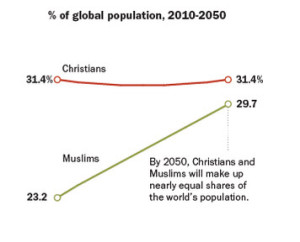 Last week the Pew Research Center released projections for how the makeup of the world’s largest religions are likely to shift between now and 2050. These projections rely on complicated assumptions and modeling designed over the last six years by team of demographers from the Pew Research Center (Washington, D.C.), and the International Institute for Applied Systems Analysis (Laxenburg, Austria).
Last week the Pew Research Center released projections for how the makeup of the world’s largest religions are likely to shift between now and 2050. These projections rely on complicated assumptions and modeling designed over the last six years by team of demographers from the Pew Research Center (Washington, D.C.), and the International Institute for Applied Systems Analysis (Laxenburg, Austria).
Globally between 2010 and 2050:
- world population will increase by 35%,
- number of Muslims will increase by 73%,
- number of Christians will increase by 35%,
- the gap in the size of these two religions will nearly close.
In the United States between 2010 and 2050:
- Christians will decline from more than three-quarters of the population in 2010 to two-thirds,
- Islam will replaced Judaism as the country’s second largest religion, and
- the unaffiliated (often called “nones”) will grow from 16% to 26%.
Food for Thought
Globally, Muslims are younger than Christians and have higher fertility rates (3.1 children per woman compared to 2.7). Projections suggest that Islam will overtake Christianity as the world’s largest religion in the early 2070s.
In the United States, the ongoing growth in the unaffiliated will counter the global trend. Globally this group will shrink from 16% to 13% while here in our country it will grow from 16% to 26%.
So What?
As a pastor in the Christian religion I find myself drawn to two statistics about changes likely by 2050: that the percentage of the global population that is Christian is expected to remain stable and that the percentage of unaffiliated/nones in the United States will rise by more than 60%.
As a professor of world religions I find myself drawn to two different statistics regarding changes between now and 2050: of all of the world’s major religious groups only Buddhists are not projected to experience growth in absolute numbers and only three religions (Islam, Christianity, and Hinduism) will have growth rates in number of adherents that will equal or exceed the global population growth.
- Which of the statistics in the Pew report stand out most to you? Why?
- Which projected change do you find most surprising? Why?
- Which (if any) of the projected changes do you disagree with or think will prove to be inaccurate? Share your thoughts as to why you think the future will look quite differently than the Pew projections suggest.